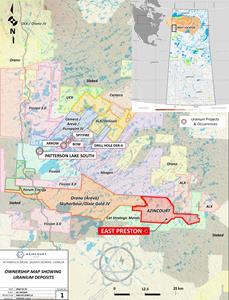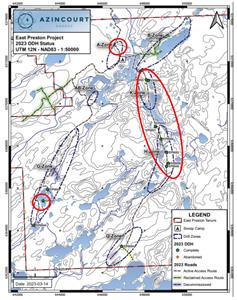Azincourt Energy Receives Results of 2024 Drilling Program at the East Preston Uranium Project
- Dravite and Kaolinite clay alteration zone expanded in K and H Zones
- Illite, Dravite and Kaolinite clay alteration identified in G Zone
- Illite and Kaolinite clay alteration identified in A Zone
VANCOUVER, British Columbia, Aug. 20, 2024 (GLOBE NEWSWIRE) -- AZINCOURT ENERGY CORP. (“Azincourt” or the “Company”) (TSX.V: AAZ, OTCQB: AZURF), is pleased to announce that the sample analysis has finally been received from the 2024 exploration program at the East Preston uranium project in the Athabasca Basin, Saskatchewan, Canada.
The 2024 drill program consisted of 1,086 meters of drilling in four diamond drill holes completed between March and April 2024. Drilling was focused on the K and H Zones (Figure 3) with initial results reported in a news release dated May 28th, 2024.
Winter 2024 Diamond Drilling Program Highlights
A total of 53 samples, including four blanks and four external standards, were collected throughout the program and sent to the Geoanalytical Laboratory at the Saskatchewan Research Council in Saskatoon, Saskatchewan for analysis. All blanks and standards returned within expected statistical norms.
Samples of clay alteration were analyzed by Short Wavelength Infrared Reflectance (SWIR, sometimes referred to as “PIMA”) to confirm the clay species. A total of 53 samples were submitted for analysis, including 33 samples from the 2024 program and 20 samples from the 2021 -2023 programs. PIMA results identify relative proportions of phyllosilicate and clay minerals including illite, chlorite, dickite, kaolinite, and dravite. Illite and kaolinite are both indicators of hydrothermal alteration typically found within alteration halos of unconformity associated uranium deposits. Dravite is a boron-rich clay which is typically found within a larger clay package in close proximity to uranium mineralization in the system. Both illite and dravite have been identified as being significant vectors for recent discoveries to the northwest of the East Preston project.
Analysis of the results shows several intervals with weakly anomalous uranium enrichment within the clay alteration zones along the K, and H- target zones (Figure 3). Uranium enrichment is identified as uranium (U) values and a uranium/thorium ratio (U/Th) above what would normally be expected in the given rock type or area.
The highest uranium result for 2024 was returned in hole EP0058 where 16 ppm U over 1.91m, including up to 21.9 ppm U over 0.51m was returned. This enriched zone sits above a zone of dravite and kaolinite clay alteration. This drill hole sits within a regional illite clay anomaly extending through the K Zone and south into the lower H Zone.
With the reevaluation and analysis of clay species in core from previous programs, the regional illite clay alteration zone identified in 2023 has been expanded to encompass the length of the K and H Zones as far south as hole EP0060 (Figure 2). Within this zone, many holes contain kaolinite +/- dravite, highlighting areas where future efforts will focus.
The reevaluation of clay species in core from previous programs has allowed the identification of illite alteration, with intervals of kaolinite and dravite in hole EP0037, drilled in 2022 on the G Zone (Figure 2). This hole previously identified an east-west cross-cutting structure which may be a primary fluid conduit to follow-up. Illite and kaolinite were also identified in EP21001, drilled in 2021 on the A Zone (Figure 2).
The company considers the identification and expansion of clay alteration halos to be significant, as major uranium discoveries in the Athabasca Basin such as McArthur River, Key Lake, and Millennium were primarily the result of drill testing of strong alteration zones related to conductor features. Identifying and upgrading the strong alteration zones is a significant step forward in identifying the key areas along the conductor trends where more attention is required.
“The alteration we are seeing continues to be very encouraging,” said VP, Exploration, Trevor Perkins. “The identification of dravite, kaolinite and illite clays with the elevated uranium along the K and H Zones emphasizes that we are in the right environment and identifying areas for closer inspection along this trend. This trend will continue to be a high priority moving forward. Based on the clay signatures in the G and A Zones, these areas will warrant a reevaluation as well,” continued Mr. Perkins.
East Preston Targets
The primary target area on the East Preston Project is the conductive corridors from the A-Zone through to the G-Zone (A-G Trend) and the K-Zone through to the H and Q-Zones (K-H-Q Trend) (Figure 2). The selection of these trends is based on a compilation of results from the 2018 through 2020 ground-based EM and gravity surveys, property wide VTEM and magnetic surveys, and the 2019 through 2022 drill programs, the 2020 HLEM survey indicates multiple prospective conductors and structural complexity along these corridors.
Drilling has confirmed that identified geophysical conductors comprise structurally disrupted zones that are host to accumulations of graphite, sulphides, and carbonates. Hydrothermal alteration, anomalous radioactivity, and elevated uranium have been demonstrated to exist within these structurally disrupted conductor zones.
Permitting and Community Engagement
Permits are in hand to conduct exploration activities at the East Preston property through the summer of 2026. Azincourt re recognizes that the granting of these permits does not negate the rights of the local communities for meaningful consultation as the project progresses. The company looks forward to a continued close working relationship and regular consultation with CRDN and other rights holders to ensure that any potential impacts and concerns are addressed and that the communities can benefit from activities in the area through support of local business, employment opportunities, and sponsorship of select community programs and initiatives. Local businesses are engaged to provide services and supplies and members of the Clearwater River Dene Nation and surrounding communities have been directly employed on site or to provide support and services to keep the camp and programs running. The involvement of the local communities is essential for continued advancement of the East Preston Project.

Figure 1: East Preston Project Location – Western Athabasca Basin, Saskatchewan, Canada

Figure 2: Zones at the East Preston Uranium Project with the areas of dravite and kaolinite clay alteration highlighted in red, overlain on 2023 drill hole location map.

Figure 3: 2024 East Preston Drill Hole Location map focused on the K and H Zones.
About East Preston
Azincourt controls a majority 78.4% interest in the 25,000+ hectare East Preston project as part of a joint venture agreement with Skyharbour Resources (TSX.V: SYH), and Dixie Gold. Three prospective conductive, low magnetic signature corridors have been discovered on the property. The three distinct corridors have a total strike length of over 25 km, each with multiple EM conductor trends identified. Ground prospecting and sampling work completed to date has identified outcrop, soil, biogeochemical and radon anomalies, which are key pathfinder elements for unconformity uranium deposit discovery.
The East Preston Project has multiple long linear conductors with flexural changes in orientation and offset breaks in the vicinity of interpreted fault lineaments – classic targets for basement-hosted unconformity uranium deposits. These are not just simple basement conductors; they are clearly upgraded/enhanced prospectively targets because of the structural complexity.
The targets are basement-hosted unconformity related uranium deposits similar to NexGen’s Arrow deposit and Cameco’s Eagle Point mine. East Preston is near the southern edge of the western Athabasca Basin, where targets are in a near surface environment without Athabasca sandstone cover – therefore they are relatively shallow targets but can have great depth extent when discovered. The project ground is located along a parallel conductive trend between the PLS-Arrow trend and Cameco’s Centennial deposit (Virgin River-Dufferin Lake trend).
Qualified Person
The technical information in this news release has been prepared in accordance with the Canadian regulatory requirements set out in National Instrument 43-101 and reviewed on behalf of the company by C. Trevor Perkins, P.Geo., Vice President, Exploration of Azincourt Energy, and a Qualified Person as defined by National Instrument 43-101.
About Azincourt Energy Corp.
Azincourt is a Canadian-based resource company specializing in the strategic acquisition, exploration, and development of alternative energy/fuel projects. The Company has been a uranium explorer for over a decade and is currently active at its majority-owned joint venture East Preston uranium project located in the Athabasca Basin, Saskatchewan, and the Big Hill lithium project, located in southwestern Newfoundland.
ON BEHALF OF THE BOARD OF AZINCOURT ENERGY CORP.
“Alex Klenman”
Alex Klenman, President & CEO
Neither the TSX Venture Exchange nor its regulation services provider (as that term is defined in the policies of the TSX Venture Exchange) accepts responsibility for the adequacy or accuracy of this release.
This press release includes “forward-looking statements”, including forecasts, estimates, expectations and objectives for future operations that are subject to a number of assumptions, risks and uncertainties, many of which are beyond the control of Azincourt. Investors are cautioned that any such statements are not guarantees of future performance and that actual results or developments may differ materially from those projected in the forward-looking statements. Such forward-looking information represents management’s best judgment based on information currently available. No forward-looking statement can be guaranteed, and actual future results may vary materially.
For further information please contact:
Alex Klenman, President & CEO
Tel: 604-638-8063
info@azincourtenergy.com
Azincourt Energy Corp.
1430 – 800 West Pender Street
Vancouver, BC V6C 2V6
www.azincourtenergy.com
Photos accompanying this announcement are available at:
https://www.globenewswire.com/NewsRoom/AttachmentNg/bc343c68-8444-44bf-adc2-d20567c4918c
https://www.globenewswire.com/NewsRoom/AttachmentNg/0147358d-e68d-4611-8eb1-21b4ee6dd968
https://www.globenewswire.com/NewsRoom/AttachmentNg/0187803b-f306-4020-b40d-b5fb25876222




